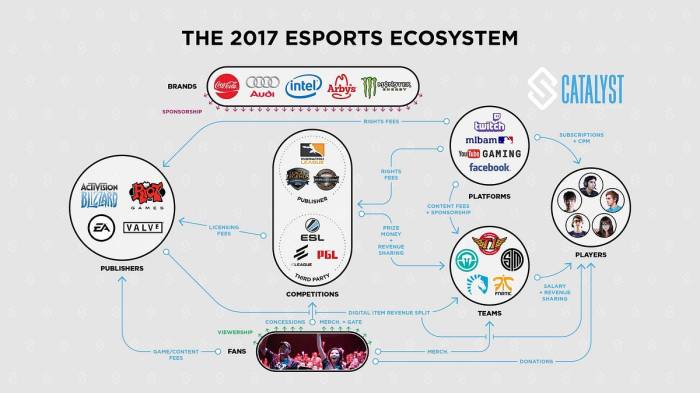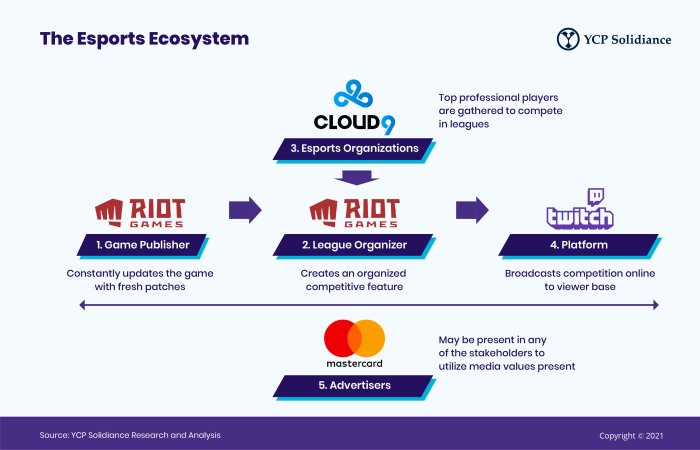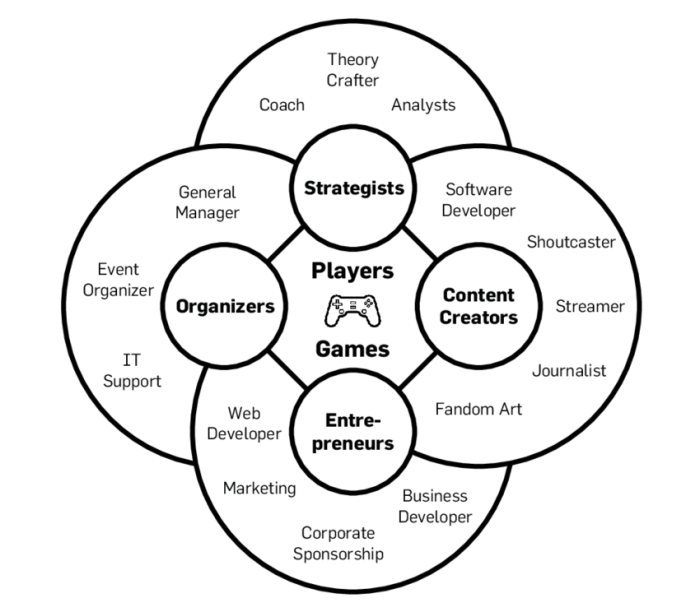Esports Ecosystem: It’s way more than just video games. This vibrant world encompasses professional teams, passionate fans, savvy sponsors, and cutting-edge technology, all working together to create a multi-billion dollar industry. From the strategic maneuvering of esports organizations to the electrifying energy of live tournaments, we’ll explore every facet of this rapidly expanding phenomenon.
We’ll dive into the business models of both major and independent esports teams, examining the roles and responsibilities of team management. We’ll also look at the crucial contributions of game publishers and developers, tournament organizers, and the ever-important role of sponsors and brands in shaping the competitive landscape. Finally, we’ll analyze the influence of technology, media, and the passionate fans who fuel this incredible growth.
Game Publishers and Developers

Game publishers and developers are the bedrock of the esports ecosystem. Without their commitment to creating engaging, competitive games and fostering thriving communities, the entire industry would crumble. Their roles are intertwined, with publishers providing the resources and marketing muscle, and developers crafting the core gameplay that fuels competition.Game publishers contribute significantly to the growth and sustainability of esports in several key ways.
They invest heavily in marketing and promotion, raising awareness of competitive scenes and attracting both players and viewers. This includes sponsoring tournaments, creating dedicated esports divisions, and working with streaming platforms to maximize reach. Furthermore, publishers often provide crucial infrastructure, such as dedicated servers and anti-cheat measures, which are essential for fair and engaging competition. They also play a vital role in managing the professional leagues and partnerships that give structure and legitimacy to the esports landscape.
Finally, they often act as gatekeepers, carefully selecting and supporting teams and players, contributing to the overall quality of the competitive scene.
The Role of Game Developers in Designing Competitive Games
Game developers are responsible for creating the fundamental framework upon which esports are built. Their design choices directly impact the game’s suitability for competitive play. This requires a deep understanding of balance, skill expression, and spectator appeal. Games designed for esports often prioritize clear mechanics, a high skill ceiling, and engaging visual presentation. For example, the emphasis on precise aiming and strategic decision-making in games like
Counter-Strike
Global Offensive* orValorant* contributes to their enduring popularity within the esports world. Conversely, games with excessive randomness or elements that are difficult to follow can hinder their potential for competitive success. The development process frequently involves iterative testing and balancing, often in close collaboration with the esports community, to ensure a fair and enjoyable competitive experience.
Key Features of Successful Esports Games, Esports Ecosystem
Several key features consistently contribute to a game’s success as an esport. These include a high skill ceiling, allowing for significant player differentiation and long-term growth in player skill; clear and easily understandable rules and mechanics, ensuring fair competition and ease of viewing; engaging gameplay that is both exciting for players and spectators; a robust anti-cheat system to maintain fair play; and a dedicated and active community that contributes to the game’s growth and longevity.
Games like
- League of Legends* and
- Dota 2*, for instance, exemplify these qualities with their complex mechanics, high skill ceilings, and extensive community engagement. The ability to easily understand the core gameplay, even for casual viewers, is also crucial for broader appeal.
Successful Publisher Strategies for Fostering Esports Communities
Successful game publishers employ various strategies to cultivate vibrant esports communities. This often involves establishing official leagues and tournaments with significant prize pools to incentivize professional competition. Many publishers also invest in community management and engagement, actively interacting with players on social media and forums, and soliciting feedback to improve the game and the competitive experience. Furthermore, the creation of readily accessible resources such as dedicated esports websites, highlight reels, and instructional videos contributes to the growth of the community.
Riot Games’ successful cultivation of theLeague of Legends* esports scene, with its intricate professional league system and extensive community engagement, serves as a prime example of a publisher effectively nurturing a thriving esports ecosystem. Their investment in infrastructure, player development, and marketing has been instrumental in the game’s continued success as a major esport.
Esports Viewers and Fans: Esports Ecosystem

The esports audience is a diverse and rapidly expanding group, crucial to the industry’s continued success. Understanding their demographics, engagement methods, and the influence of technology on their viewing habits is vital for anyone involved in the esports ecosystem. This section will delve into the characteristics of the typical esports viewer, exploring their online interactions and the factors driving the explosive growth of viewership.Esports Viewership Demographics and CharacteristicsThe stereotype of the esports viewer as a young, male gamer is partially true, but increasingly inaccurate.
While a significant portion of the audience does fall into this demographic, a growing number of women and older viewers are tuning in. Geographic location also plays a role, with certain regions exhibiting higher viewership than others, often correlating with internet penetration and the popularity of specific games. Furthermore, socioeconomic factors influence engagement, with access to high-speed internet and disposable income playing a significant role in participation.
Viewers are often highly engaged and knowledgeable about the games they watch, possessing a deep understanding of the strategies, players, and teams involved. Many are active participants in online discussions and communities surrounding their favorite esports titles.
Fan Engagement with Esports Communities
Esports fans engage with their communities in a variety of ways. Many participate in online forums and discussion boards, sharing opinions, analyzing matches, and creating fan-made content. Social media platforms like Twitter, Instagram, and TikTok are crucial for real-time engagement, allowing fans to react to live matches, interact with players and teams, and share their passion with others.
Streaming platforms such as Twitch and YouTube Gaming offer interactive features like chat functionality, enabling fans to communicate directly with each other and streamers during broadcasts. Many fans also participate in esports events themselves, attending live tournaments or watching online broadcasts with friends, creating a shared viewing experience. Furthermore, the rise of fantasy esports leagues and betting platforms provides additional avenues for fan engagement, enhancing their investment in the competitive scene.
Impact of Social Media and Streaming Platforms
Social media and streaming platforms have fundamentally reshaped the esports viewing experience. Social media provides a constant stream of information and discussion, allowing fans to stay updated on the latest news, results, and player developments. Streaming platforms offer a highly interactive viewing experience, fostering a sense of community among viewers and allowing for direct interaction with players and casters.
The ability to watch esports events live, on demand, and across multiple devices has broadened accessibility and contributed to the growth of the fanbase. Furthermore, these platforms allow for the creation and sharing of highlight reels, memes, and other fan-generated content, expanding the reach and engagement of esports beyond traditional media. The integration of social media features within streaming platforms further enhances this interactive experience, blurring the lines between watching and participating.
Factors Contributing to the Growth of Esports Viewership
The growth of esports viewership can be attributed to a confluence of factors:
- Increased Accessibility: High-speed internet and affordable streaming services have made esports easily accessible to a wider audience.
- Improved Production Quality: Professional esports broadcasts now rival traditional sports in terms of production value, enhancing the viewing experience.
- Mobile Gaming Growth: The rise of mobile gaming has introduced esports to a vast new audience, making it more accessible and convenient to watch.
- Stronger Professionalization: The establishment of professional leagues, teams, and player organizations has increased the credibility and appeal of esports.
- Increased Sponsorship and Investment: Major brands are increasingly investing in esports, raising its profile and driving its growth.
- Engaging Content Creation: The creation of high-quality highlight reels, documentaries, and other engaging content has broadened esports’ appeal to a wider audience.
- Community Building: Strong online communities have fostered a sense of belonging and engagement among esports fans, creating a loyal and dedicated audience.
Esports Media and Content Creation

The esports industry wouldn’t be where it is today without the massive contribution of media and content creation. It’s the lifeblood that connects players, teams, sponsors, and viewers, building the narrative and driving the growth of competitive gaming. From live streams to highlight reels, analytical breakdowns to in-depth documentaries, the range of esports media is vast and constantly evolving.Esports media and content creation encompasses a wide variety of formats designed to engage and inform audiences about the competitive gaming world.
This includes live broadcasts of tournaments, highlight videos showcasing exceptional plays, pre- and post-match analysis, news articles and features covering the industry, documentary-style productions exploring the lives of players and teams, and even comedic or entertaining content focused on esports culture. This diverse range ensures there’s something for every type of fan, from casual viewers to hardcore enthusiasts.
Types of Esports Media and Content
Esports media is incredibly diverse. It ranges from the raw excitement of live tournament broadcasts to the meticulously crafted analysis that deep-dives into strategies and player performance. We see short-form content like highlight reels on platforms like YouTube and Twitch, designed for quick consumption and viral spread. Longer-form content, such as documentaries or in-depth interviews, provide more context and background to the esports world.
Finally, there’s the ever-growing landscape of esports journalism, which provides news, features, and opinion pieces, keeping fans up-to-date on the latest developments.
The Roles of Esports Commentators, Analysts, and Journalists
The success of esports media heavily relies on the expertise and presentation skills of its key personnel. Esports commentators provide real-time narration during live broadcasts, building excitement and explaining the action to viewers. Analysts offer deeper insights into gameplay, strategies, and player performance, enriching the viewing experience for those seeking a more strategic understanding. Esports journalists, meanwhile, report on news, events, and trends within the industry, maintaining a critical perspective and holding the community accountable.
Their work provides context, allowing viewers to better understand the business, competitive, and cultural aspects of esports. Think of them as the sports reporters of the digital age.
Successful Esports Content Creation Strategies
Successful esports content creation often involves a multi-pronged approach. High-quality production value is crucial, ensuring a polished and professional presentation that attracts and retains viewers. Engaging storytelling is also key; weaving compelling narratives around players, teams, and competitions can create emotional connections with the audience. Finally, understanding the target audience and tailoring content to their preferences is essential for maximizing reach and engagement.
For example, a shorter, highlight-reel style video might work well for casual viewers on platforms like TikTok, while a longer, in-depth documentary might appeal to more dedicated fans on YouTube. The strategy should be data-driven, using analytics to inform decisions about content creation and distribution.
Sample Esports News Article: Team Liquid’s Historic Dota 2 Victory
Team Liquid Claims Unprecedented Third TI ChampionshipTeam Liquid, led by the legendary captain Kuro “KuroKy” Salehi Takhasomi, etched their names into Dota 2 history by securing their third The International (TI) championship. Their victory at TI12 was a stunning display of teamwork, strategy, and individual brilliance, culminating in a decisive 3-0 sweep against their opponents. The win marks a historic achievement, solidifying Team Liquid’s position as one of the greatest Dota 2 teams of all time and earning them a record-breaking prize pool share.
This victory also underscores the incredible resilience and dedication of the team, who overcame significant challenges throughout the tournament to claim the ultimate prize. The event showcased the global reach and competitive intensity of the Dota 2 scene, with millions of viewers worldwide tuning in to witness the epic conclusion. The win has already sparked conversations about Team Liquid’s legacy and the future of competitive Dota 2.
FAQ Explained
What’s the average lifespan of a professional esports player’s career?
It varies greatly depending on the game, skill level, and individual circumstances, but generally, it’s shorter than traditional sports, often lasting 3-7 years.
How do esports teams make money besides sponsorships?
They generate revenue through prize money from tournaments, merchandise sales, streaming revenue, and sometimes investments or partnerships.
What are the biggest challenges facing the esports industry?
Major challenges include player burnout, maintaining competitive balance, combating toxicity in online communities, and securing long-term sustainability for teams and organizations.
How do game developers influence the competitive scene?
Developers directly impact the competitive scene through game balance patches, the addition of new game modes, and the overall design choices that make a game suitable for competitive play.
